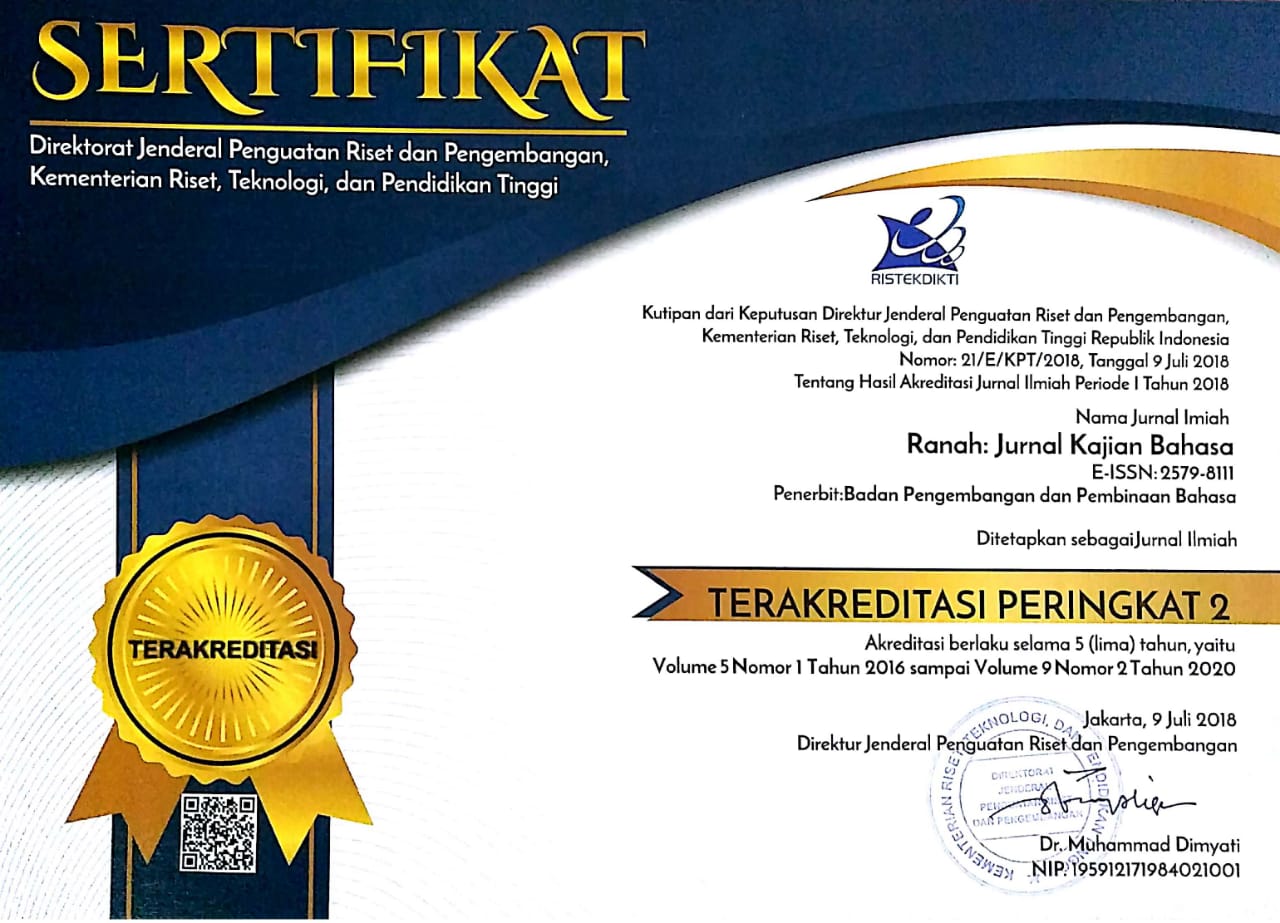Strategi Penerjemahan Kata Zina dan Rafas: Sebuah Reinterpresentasi
Abstract
While a growing body of research on translation strategy produced by novice translators have been undertaken by many scholars, there is a paucity of research on 'zina' and 'rafas' translation strategy from Arabic to Indonesian. To fill this lacuna, the present study aims to analyze novice translators strategy for rendering the words zina and rafas and why they used it. The present study adopted translation process research design and translation strategy theory proposed by Gambier (2010). The findings demonstrate that the meaning of adultery is not restricted to "sexual intercourse between a man and a woman who is not bound by a marriage contract", but also "female genitalia". Similarly, the word rafas refers to "intercourse," and also "making out" or "kissing." The novice translators discovered the meaning by employing the following four translation strategies:(1) searching and reading articles regarding the meaning of zina dan rafas through Publish or Perish dan Elicit Application, (2) downloading and reading multilingual dictionary, (3) downloading and reading monolingual dictionary, and (4) listening to lectures via YouTube. Convenience, language problems, and user satisfaction are tree factors that influence novice translator decisions to adopt the translation strategy. This study suggests that the meaning of the two words should be reviewed by utilizing annotation or addition translation techniques.
Abstrak
Meskipun penelitian tentang strategi penerjemahan oleh penerjemah pemula telah banyak didokumentasikan para sarjana, masih sedikit yang menganalisis strategi penerjemahan kata zina dan rafas dari bahasa Arab ke bahasa Indonesia. Untuk mengisi kesenjangan penelitian tersebut, penelitian ini bertujuan untuk menganalisis strategi penerjemahan kata zina dan rafas oleh penerjemah pemula dan mengapa mereka menggunakannya. Penelitian ini menggunakan desain penelitian proses penerjemahan dan teori strategi penerjemahan Gambier (2010). Hasil penelitian menunjukkan bahwa kata zina tidak hanya bermakna 'perbuatan’ bersenggama antara laki-laki dan perempuan yang tidak terikat kontrak pernikahan' tetapi juga 'alat kelamin perempuan'. Demikian pula, kata rafas tidak hanya terbatas pada makna 'bersenggama', tetapi juga 'bercumbu rayu' dan 'berciuman'. Hasil penelitian ini menemukan bahwa ada empat strategi penerjemahan yang digunakan penerjemah pemula dalam mencari makna kedua kata tersebut, yaitu (1) melakukan navigasi dan membaca artikel tentang arti zina dan rafas melalui aplikasi Publish or Perish dan Elicit; (2) mengunduh dan membaca kamus multibahasa; (3) mengunduh dan membaca kamus satu bahasa; dan (4) mendengarkan ceramah melalui YouTube. Persoalan kemudahan, masalah bahasa, dan kepuasan pengguna merupakan tiga faktor penyebab mengapa strategi penerjemahan digunakan. Akhirnya, penelitian ini menyarankan untuk diadakan peninjauan ulang terhadap makna kedua kata tersebut dengan menggunakan teknik anotasi atau adisi.
Keywords
Full Text:
PDF (Bahasa Indonesia)References
Abdelwahab, D. A. M. (2022). Translation strategies applied in English-Arabic translation: A case of a website article. World Journal of English Language, 12(1), 275-275. https://doi.org/10.5430/wjel.v12n1p275
Al-Jabri, H. (2020). Purification strategy in the Arabic translations of diary of A Wimpy Kid. International Journal of Arabic-English Studies, 20(1), 187-202. https://doi.org/10.33806/ijaes2000.20.1.10
Al-Khalafat, L., & Haider, A. S. (2022). A corpus-assisted translation study of strategies used in rendering culture-bound expressions in the speeches of King Abdullah II. Theory and Practice in Language Studies, 12(1), 130-142. https://doi.org/10.17507/tpls.1201.16
Al-Rahmi, W. M., Othman, M. S., Yusof, L. M., & Musa, M. A. (2015). Using social media as a tool for improving academic performance through collaborative learning in Malaysian higher education. Review of Europian Studies, 7(3), 265-273. https://doi.org/10.5539/res.v7n3p265
Alharahsheh, A. M. (2020). Strategies employed by Jordanian subtitlers in translating the dialect used in the movie "Theeb." Pertanika Journal of Social Sciences & Humanities, 28(S2), 109-120.
Almobarraz, A. (2018). Utilization of YouTube as an information resource to support university courses. The Electronic Library, 36(1), 71-81. https://doi.org/10.1108/EL-04-2016-0087
Baker, M. (2018). In other words: A coursebook on translation (3rd ed.). Routledge. https://doi.org/10.4324/9781315619187
Carl, M., Dragsted, B., & Jakobsen, A. L. (2011). On the systematicity of human translation processes. In Tralogy I. Métiers et technologies de la traduction: quelles convergences pour l'avenir.
Castellani, M. M. (2020). Alain de Lille. Nord, 1, 65-70. https://doi.org/10.3917/nord.075.0065
Castro-Romero, O. (2015). Social Media as learning tool in higher education: The case of Mexico and South Korea. Sinéctica, 44(1), 1-16.
Fatih, M. (2018). Pendidikan seks dalam al-Qur'an: Perspektif tafsir tarbawi tentang larangan mendekati zina. Ta'dibia: Jurnal Ilmiah Pendidikan Agama Islam, 8(2), 7-14. https://doi.org/10.32616/tdb.v8.2.176.7-14
Gambier, Y. (2010). Translation strategies and tactics. Handbook of Translation Studies, 1, 412-418. https://doi.org/10.1075/hts.1.tra7
Gunawan, F., Nababan, M. R., Syukri, H., & Burdah, I. (2022). Revisiting interpretive translation method: A case study of Muhammad Thalib's Quranic translation. Jordan Journal of Modern Languages and Literatures, 14(1), 111-127. https://doi.org/10.47012/jjmll.14.1.6
Hamid, S., Waycott, J., Kurnia, S., & Chang, S. (2015). Understanding students' perceptions of the benefits of online social networking use for teaching and learning. The Internet and Higher Education, 26(1), 1-9. https://doi.org/10.1016/j.iheduc.2015.02.004
Huda, S. (2015). Zina dalam perspektif hukum Islam dan kitab Undang Undang Hukum Pidana. Hunafa: Jurnal Studia Islamika, 12(2), 377-397. https://doi.org/10.24239/jsi.v12i2.401.377-397
Hvelplund, K. T. (2017). Translators' use of digital resources during translation. HERMES-Journal of Language and Communication in Business, 56(1), 71-87. https://doi.org/10.7146/hjlcb.v0i56.97205
Kisworo, B. (2016). Zina dalam kajian teologis dan sosiologis. Al-Istinbath: Jurnal Hukum Islam, 1(1), 1-24.
Kosterelioglu, I. (2016). Student views on learning environments enriched by video clips. Universal Journal of Educational Research, 4(2), 359-369. https://doi.org/10.13189/ujer.2016.040207
Krings, H. P. (1986). Translation problems and translation strategies of advanced German learners of French. In J. House & S. Blum-Kulka (Eds.), Interlingual and intercultural communication (pp. 263-276). Gunter Narr.
Lörscher, W. (1991). Translation performance, translation process, and translation strategies. A psycholinguistic investigation. Gunter Narr.
Moghavvemi, S., Sulaiman, A., Jaafar, N. I., & Kasem, N. (2018). Social media as a complementary learning tool for teaching and learning: The case of youtube. The International Journal of Management Education, 16(1), 37-42. https://doi.org/10.1016/j.ijme.2017.12.001
Molina, L., & Albir, A. H. (2002). Translation techniques revisited: A dynamic and functionalist approach. Meta, 47(4), 498-512. https://doi.org/10.7202/008033ar
Nord, C. (1991). Text analysis in translation. Theory, methodology, and didactic application of a model for translation-oriented text analysis. Rodopi.
Qassem, M. (2021). Translation strategy and procedure analysis: a cultural perspective. Asia Pacific Translation and Intercultural Studies, 8(3), 300-319. https://doi.org/10.1080/-23306343.2021.2003511
Rajai, A. K., & Ennasser, N. (2022). Dealing with dialects in literary translation: Problems and strategies. Jordan Journal of Modern Languages and Literatures, 14(1), 145-163. https://doi.org/10.47012/jjmll.14.1
Robert, I. S., Terryn, A. R., Ureel, J. J., & Remael, A. (2017). Conceptualising translation revision competence: A pilot study on the tools and research subcompetence. JoSTrans: The Journal of Specialised Translation.-London, 28(1), 293-316. https://doi.org/10.1080/-0907676X.2017.1330894
Rohman, A. (2019). Seksual dalam al-Qur'an. Jurnal Studi Ilmu-Ilmu Al-Qur'an Dan Hadis, 20(1), 105-125. https://doi.org/10.14421/qh.2019.2001-06
Snelson, C. (2018). The benefits and challenges of YouTube as an educational resource. In The Routledge companion to media education, copyright, and fair use (pp. 203-218). https://doi.org/10.4324/9781315637549-15
Sobaih, A. E. E., Moustafa, M. A., Ghandforoush, P., & Khan, M. (2018). To use or not to use? Social media in higher education in developing countries. Computers in Human Behavior, 58, 296-305. https://doi.org/10.1016/j.chb.2016.01.002
Talebe, T. (2019). Zina dalam perspektif tafsir Al-Qur'an. Musawa: Journal for Gender Studies, 11(1), 1-13. https://doi.org/10.24239/msw.v11i1.439
Vinay, J.-P., & Darbelnet, J. (1958). Stylistique comparée du français et de l'anglais [Comparative stylistics of French and English. Beauchemin.
Vurayai, S., & Ndofirepi, A. P. (2020). Publish or perish': implications for novice African university scholars in the neoliberal era. African Identities, 1-14. https://doi.org/10.1080/-14725843.2020.1813084
Wiyono, A. H., & Manaf, L. A. (2020). Pacaran dan zina: Kajian kekinian perspektif al-Qur'an. Samawat, 4(2), 48-55.
DOI: https://doi.org/10.26499/rnh.v11i2.4904
Refbacks
- There are currently no refbacks.








